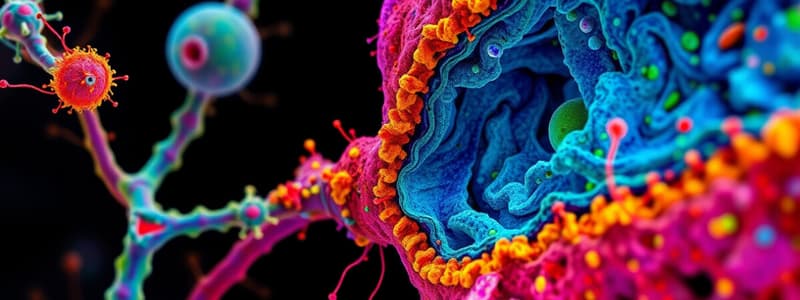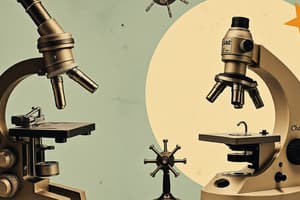Podcast
Questions and Answers
What technique uses light to permit magnification and viewing of cellular structures?
What technique uses light to permit magnification and viewing of cellular structures?
- Light microscopy (correct)
- Scanning electron microscopy
- Cell fractionation
- Transmission electron microscopy
What is scanning electron microscopy?
What is scanning electron microscopy?
A process that utilizes an electron beam to produce an image of the three-dimensional surface of biological samples.
What is transmission electron microscopy?
What is transmission electron microscopy?
A technique where electrons penetrate an ultrathin section of tissue to strike a photographic plate.
What is cell fractionation?
What is cell fractionation?
What is cytosol?
What is cytosol?
What is a nucleoid?
What is a nucleoid?
What is chromatin?
What is chromatin?
What is the nucleus?
What is the nucleus?
What is the function of the nucleolus?
What is the function of the nucleolus?
What is the nuclear envelope?
What is the nuclear envelope?
What are ribosomes?
What are ribosomes?
What is the nuclear lamina?
What is the nuclear lamina?
What is the endoplasmic reticulum?
What is the endoplasmic reticulum?
What is rough ER?
What is rough ER?
What does the smooth ER do?
What does the smooth ER do?
What are glycoproteins?
What are glycoproteins?
What are vesicles?
What are vesicles?
What is the golgi apparatus?
What is the golgi apparatus?
What is a lysosome?
What is a lysosome?
What is phagocytosis?
What is phagocytosis?
What is a food vacuole?
What is a food vacuole?
What is a central vacuole?
What is a central vacuole?
What are mitochondria?
What are mitochondria?
What are chloroplasts?
What are chloroplasts?
What is the endosymbiont theory?
What is the endosymbiont theory?
What is the mitochondrial matrix?
What is the mitochondrial matrix?
What are cristae?
What are cristae?
What are thylakoids?
What are thylakoids?
What are grana?
What are grana?
What is stroma?
What is stroma?
What are plastids?
What are plastids?
What are peroxisomes?
What are peroxisomes?
What is the cytoskeleton?
What is the cytoskeleton?
What are motor proteins?
What are motor proteins?
What are microtubules?
What are microtubules?
What are microfilaments?
What are microfilaments?
What are intermediate filaments?
What are intermediate filaments?
What is keratin?
What is keratin?
What is actin?
What is actin?
What is tubulin?
What is tubulin?
What is a centrosome?
What is a centrosome?
What are centrioles?
What are centrioles?
What are cilia?
What are cilia?
What are flagella?
What are flagella?
What is a basal body?
What is a basal body?
What is dynein?
What is dynein?
What is myosin?
What is myosin?
What are pseudopodia?
What are pseudopodia?
What is cytoplasmic streaming?
What is cytoplasmic streaming?
What is a cell wall?
What is a cell wall?
What is the middle lamina?
What is the middle lamina?
What is a primary cell wall?
What is a primary cell wall?
What is a secondary cell wall?
What is a secondary cell wall?
What is the extracellular matrix?
What is the extracellular matrix?
What are proteoglycans?
What are proteoglycans?
What is fibronectin?
What is fibronectin?
What are integrins?
What are integrins?
What are plasmodesmata?
What are plasmodesmata?
What are gap junctions?
What are gap junctions?
What are tight junctions?
What are tight junctions?
What are desmosomes?
What are desmosomes?
Which proteins are synthesized by free ribosomes?
Which proteins are synthesized by free ribosomes?
Which proteins are synthesized by bound ribosomes?
Which proteins are synthesized by bound ribosomes?
How does bound ribosome protein synthesis work?
How does bound ribosome protein synthesis work?
Which of the following proteins are synthesized by bound ribosomes?
Which of the following proteins are synthesized by bound ribosomes?
Which structure manufactures cellular membranes by adding proteins and phospholipids?
Which structure manufactures cellular membranes by adding proteins and phospholipids?
What does the smooth ER do?
What does the smooth ER do?
_____ is/are identical in structure to centrioles.
_____ is/are identical in structure to centrioles.
What do peroxisomes produce as a by-product?
What do peroxisomes produce as a by-product?
What is crenation?
What is crenation?
What is hemolysis?
What is hemolysis?
What does a central vacuole do?
What does a central vacuole do?
Under which condition would you expect to find a cell with predominance of free ribosomes?
Under which condition would you expect to find a cell with predominance of free ribosomes?
Which of the following contain the 9 + 2 arrangement of microtubules?
Which of the following contain the 9 + 2 arrangement of microtubules?
What can be deduced about celery stalk cells immersed in fresh water?
What can be deduced about celery stalk cells immersed in fresh water?
The movement of potassium into an animal cell requires?
The movement of potassium into an animal cell requires?
What side of the ER membrane will the ATP binding site of the sodium-potassium pump be on?
What side of the ER membrane will the ATP binding site of the sodium-potassium pump be on?
Flashcards are hidden until you start studying
Study Notes
Light and Electron Microscopy
- Light Microscopy: Uses light to magnify and view cellular structures up to 1000 times their natural size.
- Scanning Electron Microscopy: Utilizes an electron beam for three-dimensional imaging of a sample's surface; samples are coated with heavy metals like gold.
- Transmission Electron Microscopy: Involves electrons penetrating ultra-thin tissue sections to create images on photographic plates.
Cellular Structure and Functions
- Cell Fractionation: Technique for breaking cells apart and separating their components.
- Cytosol: Aqueous component of cytoplasm where organelles are suspended.
- Nucleoid: Dense region of DNA in prokaryotic cells.
- Chromatin: DNA strands in eukaryotic nuclei, condense to form chromosomes.
- Nucleus: Organelle containing DNA, which controls cell processes.
- Nucleolus: Site within the nucleus for ribosome production.
- Nuclear Envelope: Double membrane with pores regulating material flow in and out of the nucleus.
- Ribosomes: Composed of protein and RNA, essential for protein synthesis in the cytoplasm.
Endoplasmic Reticulum and Golgi Apparatus
- Endoplasmic Reticulum (ER): Internal membrane system for constructing cell membrane components and proteins.
- Rough ER: Studded with ribosomes, synthesizes phospholipids for the cell membrane.
- Smooth ER: Synthesizes lipids, metabolizes carbohydrates, detoxifies drugs, and stores calcium.
- Golgi Apparatus: Modifies, sorts, and packages proteins from the ER.
Cellular Organelles
- Lysosome: Contains enzymes for breaking down cellular materials.
- Vesicles: Small membrane sacs for transporting products within a cell.
- Mitochondria: Powerhouse organelle for ATP production.
- Chloroplast: Captures sunlight to produce food in plant cells through photosynthesis.
- Peroxisomes: Contain enzymes to detoxify harmful compounds.
Cytoskeleton and Movement
- Cytoskeleton: Network of actin filaments and microtubules providing cell shape and support.
- Microtubules: Hollow protein tubes aiding in structural support and organelle movement.
- Microfilaments: Solid protein rods enabling cell movement and shape changes.
- Intermediate Filaments: Support cell structure and position organelles.
- Motor Proteins: Facilitate movement along cytoskeletal elements.
Cell Walls and Extracellular Matrix
- Cell Wall: Strong, supportive layer made of cellulose in plants; provides structure.
- Middle Lamina: Adhesive layer between plant cell walls.
- Extracellular Matrix (ECM): Substance surrounding animal cells composed of proteins and polysaccharides.
- Proteoglycans: Glycoproteins in the ECM that consist of core proteins with carbohydrate chains.
Intercellular Connections
- Plasmodesmata: Channels in plant cell walls allowing cytosol connection between cells.
- Gap Junctions: Cytoplasmic channels between adjacent animal cells.
- Tight Junctions: Prevent leakage of extracellular fluid between neighboring cells.
- Desmosomes: Specialized junctions holding adjacent cells together.
Ribosomes and Protein Synthesis
- Free Ribosomes: Synthesize proteins that function in the cytosol or nucleus.
- Bound Ribosomes: Produce proteins for the endomembrane system or secretion.
- Signal Sequence: First amino acids of a protein indicating it should enter the ER for further processing.
Cell Transport and Solutions
- Crenation: Shrinking of a cell in a hypertonic solution.
- Hemolysis: Bursting of a cell in a hypotonic solution.
- Central Vacuole: Stores compounds, maintains turgor pressure, and regulates cytoplasm composition in plant cells.
Membrane and Transport Proteins
- Sodium-Potassium Pump: Requires ATP from the cytoplasm to transport ions across the plasma membrane.
- Centrosomes: Microtubule-organizing centers essential for cell division.
Miscellaneous
- Endosymbiont Theory: Suggests that mitochondria and chloroplasts originated from engulfed prokaryotic cells.
- Cilia and Flagella Structure: Both possess a "9+2" arrangement of microtubules for movement.
- Cytoplasmic Streaming: Circular flow of cytoplasm enhancing material distribution within cells.
Studying That Suits You
Use AI to generate personalized quizzes and flashcards to suit your learning preferences.




